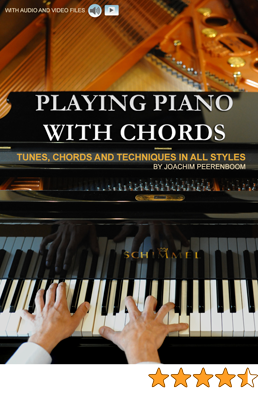To create another rhythmic pattern for the pop ballad progression, you can use the same ninth chords from the previous post and arpeggiate them. This simply means playing the notes of each chord one after another instead of playing the notes at the same time.
Playing arpeggios
An eighth note arpeggio pattern could look like this. Again, the pedal is used to add more depth and flow to the music.

Looking for more ballad piano chords and patterns?
Mixing rhythmic patterns
Now that you know two different right hand patterns for this chord progression, you can mix them to get an even better sound. This will create more variation, even though it isn’t much harder to play.
Here is an example where you play the second pattern in bar 1, then the first pattern in bar 2 and keep alternating the two variations throughout the progression.

A simple formula for ballad piano
Now you have a formula to create nice pop ballad chord progressions on the piano:
- find a chord progression that you like
- find inversions to create a good voice leading
- add bass notes in the left hand
- add the ninth to some or all the chords (whichever you prefer)
- create rhythmic patterns (or use the same ones you just learned)
- alternate the patterns to create more variation.
Of course it doesn’t have to end here. You could create other patterns, play more notes in the left hand, use different chord voicings and so on. But with the few steps outlined above you can create some very beautiful piano music from scratch!



